Land Birds of
New Zealand
| |
| HOME |
| About Tenaya |
| About Us |
| Latest Update |
| Logs from Current Year |
| Logs from Previous Years |
| Katie's View |
| Route Map |
| Links |
| Contact Us |
![]()
We didn't set out to study birds as part of our New Zealand experience but it is a bit like with fish. When a colorful or interesting one catches our eye we want to know about it. So armed with a camera and bird identification book we're wandering around New Zealand snapping shots of any feathered creature gracious enough to strike a pose.
Because there are so many birds, we have separated them onto two pages, one for those found mainly in the country, forest, mountains or sanctuaries and the other page for those found normally near water, whether it be salt or fresh. Land birds are featured on this page.

Kea - Luxmore Hut, Kepler Track, Fiordland
Native, found only in NZ. Common in places. One of the world's few alpine parrots. Lives in the South Island at or above timberline. Quite intelligent and inquisitive, they learn from experience. Often playful and comical. One bird visits the manager at Deep Cove in Doubtful Sound most mornings for a dab of butter, climbing up his leg and sitting on his knee. Can live over 20 years.
Eastern Rosella - Waitangi
Introduced. Common in places. Arrived as a caged bird from Australia and is still found only in areas near where the original birds escaped.
Red-Crowned Parakeet - Ulva Island
Native. Common in places. Often flies above the canopy or side-slips through the trees. Rare in native forests on main islands but common on Stewart Island and predator free islands. Indeed, we saw, and heard, two at Ulva Island.
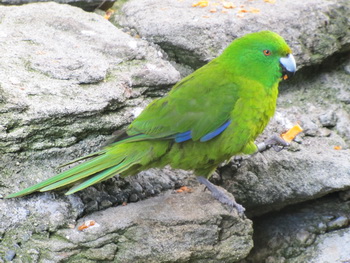
Antipodes Parakeet - Te Anau
Native. Rare. Found only in New Zealand. Completely green head and body except for blue on wings. Larger than other parakeets. Only about 50 birds survive on the main islands where they are managed in case something were to happen to the natural habitat of the 2000 birds residing on the subantarctic islands.
Kaka - Oban, Stewart Island
Native, found only in NZ. Not common. Large parrot usually found in mature native forest. They behave like monkeys, using their bills and feet to climb and swing through the branches. Some can live more than 20 years. This particular bird, along with two others, came looking for hazelnuts at a house we were visiting in Oban. One walked right in and came towards the table while we were having dinner. Fortunately they are not destructive like keas.

Takahe - Tiritiri Matangi Island
Native. Found only in New Zealand. Only about 200 birds exist today. Thought to be extinct for 50 years until observed in 1948 near Lake Te Anau on the South Island. They have been introduced to sanctuaries around the country including Tiritiri Matangi Island Open Sanctuary. This is Greg. He is about 18 years old and has learned that bags mean goodies. He struts around the Visitor's Center, where guests eat lunch, hoping to steal a tidbit. A human escort makes sure he receives nothing. Three times the size of a pukeko, they have shorter, heavier legs and are as tall as a man's knees. They have lost their ability to fly. Live 14-20 years.
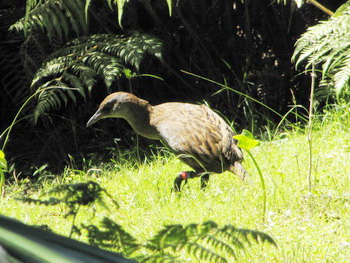
North Island Weka - Kawau Island

Western Weka - Abel Tasman Nat'l. Park

Stewart Island Weka - Ulva Island
Native. Found only in NZ. Common in places. There are four subspecies. Although it has wings, it cannot fly but is a fast runner, running with its neck outstretched. Believed to have originally flown to NZ as a wetland bird and slowly evolved into a forest bird with no need to fly. It is very curious and will walk some distance to check out people and campsites. Will steal just about anything from food to silverware. Forages by flicking away leaves or digging holes with its beak. Can live over 15 years.
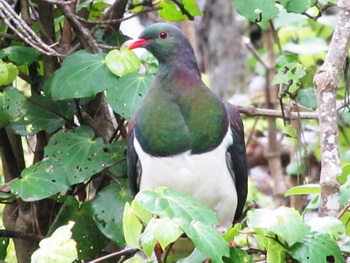
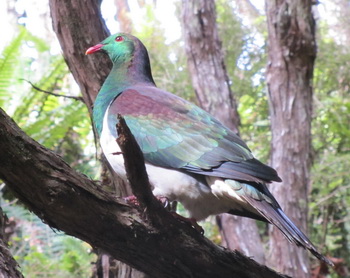
New Zealand Pigeon - Tutukaka & Stewart Island
Native. Found only in NZ. Also known as a Wood Pigeon. One of the world's most beautiful pigeons. Large and clumsy with noisy wingbeats, it crashes through the branches of the forest and eats a large variety of fruit. Berries in their stomachs flavor the meat which makes them a desirable food for the Maori. As their numbers have been declining, there is now a $250,000 fine for killing them for food. Can live for 10 years.
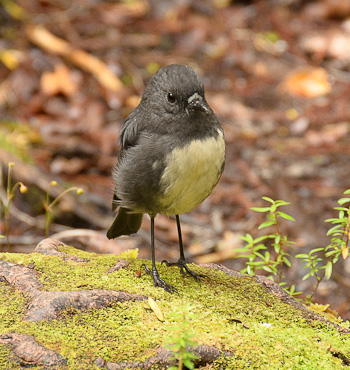
South Island Robin - Anchor Island, Dusky Sound, Fiordland

Stewart Island Robin - Track to Mason Bay
Native. Found only in New Zealand. Not common. Three subspecies, one for each main island. Friendly and curious. Hops about on the ground in search of insects and worms. Several flew from branch to branch at eye level as we hiked along the trail. They stayed as long as we stayed, looking at us often hopping to the ground and right up to our feet. Adorable creatures that we just love! Unrelated to the robin red-breast. Can live more than 16 years.
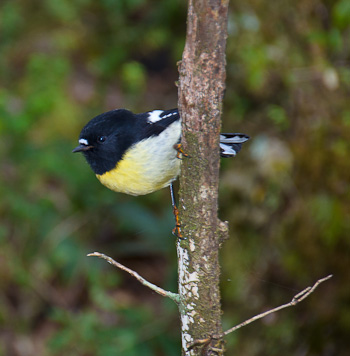
Tomtit - Pickersgill Harbour, Dusky Dound
Native, found only in NZ. Common. South Island and Stewart Island tomtits have yellowish breasts while North Island birds have white. Males are black and females are brown. Friendly birds, they fly from low perches to eat insects on the ground. There are 5 sub-species and one helped save the black robin from extinction by incubating spare eggs given to it by conservation workers. Can live 10 years.
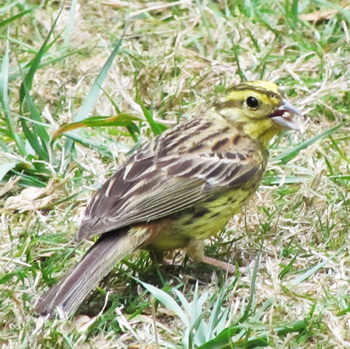
Yellowhammer - Abel Tasman Nat'l. Park
Introduced. Very common. This bird's pretty song is said to have been the inspiration for the opening lines of Beethoven's Fifth Symphony. Lives about 10 years. This particular bird is a juvenile.
Yellowhead - Ulva Island
Native. Rare. Found only on the South Island in mature native forests, usually red beech. Eats insects and spiders and uses its tail feathers for support when feeding on the trunks of trees. Often confused with the common yellowhammer, this bird has a black beak and black legs. Male has bright yellow head and underparts while the crown and nape of females and juveniles are shaded brown. Can live 12 years. This bird is one of about 70 on Ulva Island.
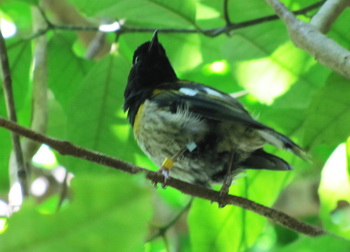
Stitchbird - Tiritiri Matangi Island
Native. Found only in sanctuaries in New Zealand. The name comes from its call. It is the only bird in the world known to mate face to face. Can live up to 7 years.
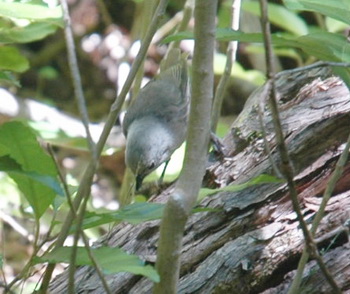
Whitehead - Tiritiri Matangi Island
Native. Only found on the North Island of New Zealand. Not common. In summer, autumn and winter they fly in noisy, fast-moving flocks. To Maori, these flocks were a warning that ghosts were nearby.
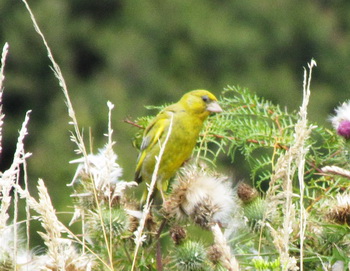
Greenfinch - Stewart Island
Introduced. Common. Yellow on tail and wings is seen during flight. Only male sings. Brought from Europe in the 1860s and is now common in gardens, farmland, orchards and the edges of pine forest. Eats fruit and some insects which it is happy to pick out of car grills. Sometimes kept as a cage bird. Can live to about 10 years.
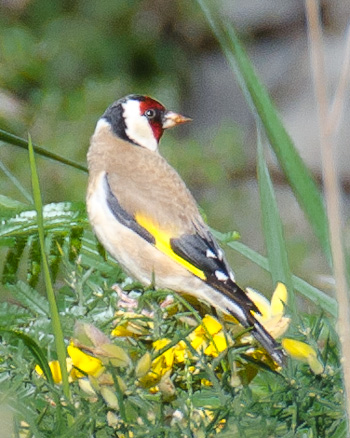
Goldfinch - Opua to Pahia trail
Introduced. Very common. Males and females look the same. Because of its vibrant colors many were trapped in 19th century England for caged birds. Lives about 8 years.
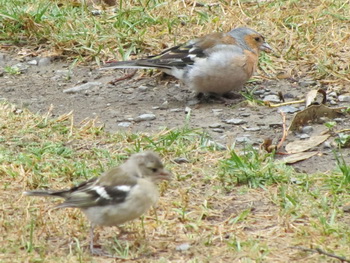
Chaffinch - Hanmer Springs
Introduced. Very common. Found just about everywhere in NZ, they feed on the ground shuffling about. The male is much more colorful than the female. In winter they form flocks of several hundred birds, often all of the same sex. Lives about 10 years.
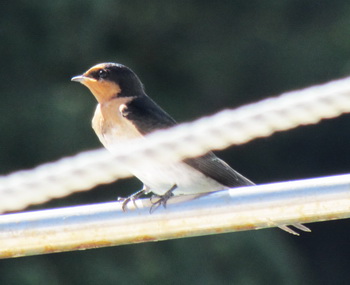
Welcome Swallow - Gulf Harbour
Native. Common. Fly erratically not unlike bats. Have been known to collide mid-air. Makes nest of mud and saliva lined with feathers or wool. Attaches to beams beneath bridges, inside pipes, on cliffs, under eaves of buildings or in the awnings of moored yachts. Hmm... this bird was sitting on the boat next to Tenaya. Was it waiting for us to leave?
.jpg)
Brown Creeper - Pickersgill Harbour, Dusky Sound, Fiordland
Native. Common in places. Found only on the South Island and Stewart Island usually in native and pine forests but sometimes in scrub too. Feeds by moving over tree trunks looking for insects. Related to whitehead and yellowhead. Forms small noisy, fast-moving flocks high in the forest canopy. The longtailed cuckoo often lays its eggs in the brown creepers nest leaving the smaller bird to raise the young cuckoo. The cuckoo will grow to ten times the weight of the brown creeper.
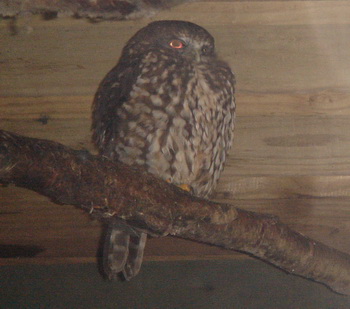
Morepork - Rotorua
Native. Fairly common. NZ's only native owl, it sleeps during the day well-hidden on a branch, fork or in a hole of a tree. It hunts large moths, flying beetles, small birds, mice, rats and lizards, quietly swooping in on prey which soft feathers along the edges of its wings allow. A similar subspecies was saved from extinction on Norfolk Island in 1987 when two NZ moreporks were taken there to mate with the last female.
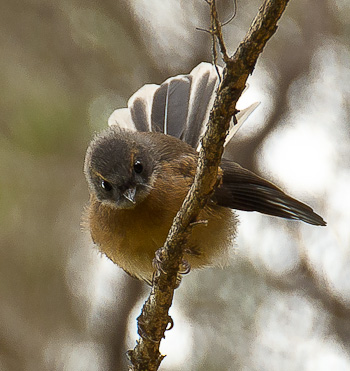
Fantail - Kepler Track, Fiordland
Native. Very common. Found in forests, scrubs, gardens, anywhere there are trees. Enters houses in summer looking for flies. Enjoys bathing in the spray of garden hoses. May settle on shoulders, heads or outstretched hands. Attracted by rubbing a cork on a wet bottle. Suddenly switches direction in flight to snap up flying insects. Because of these jerky movements, Maori described a restless person as being like a fantail. The oldest one found in NZ was 3 years old.
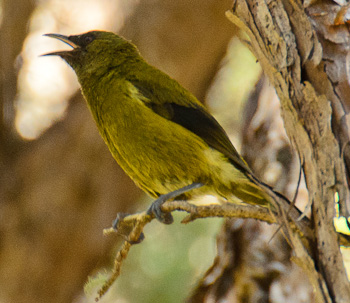
Bellbird - Torrent Bay, Abel Tasman National Park
Native. Found only in NZ. Common. Beautiful song sounds like bells ringing or flutes playing. Both male and females sing throughout the year. Feeds on insects and nectar, helped by its brush-like tongue. Can live more than 8 years.
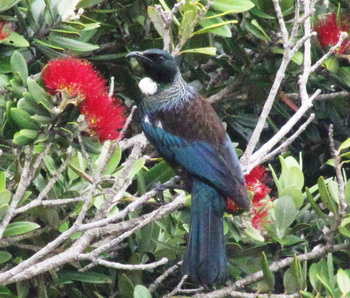
Tui - Tutukaka
Native. Common. Also called the Parson's Bird for the white tufts at its collar. Varied and distinctive song including grunts, coughs and gurgles. Maori kept them in cages and trained them to memorize and repeat elaborate Maori welcome speeches of up to seventy words. The bristles of its brushlike tongue was even trimmed to help the bird speak more clearly. It's said that it is able to imitate the call of every bird in the forest as well as crowing roosters, barking dogs, an old man's cough, a child's laughter and even the sound of a car alarm. It has been protected since 1873. Can live more than 12 years.
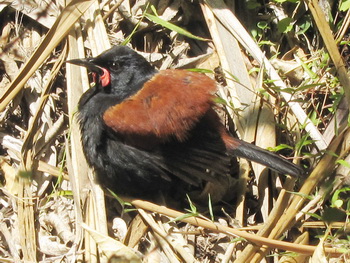
Saddleback - Tiritiri Matangi Island, Ulva Island
Native. Found only in sanctuaries in New Zealand. Has small orange-red wattles on either side of beak and a rusty brown "saddle" on its back. Belongs to the wattlebird family, a family with no close relatives anywhere else in the world. May live more than 17 years.
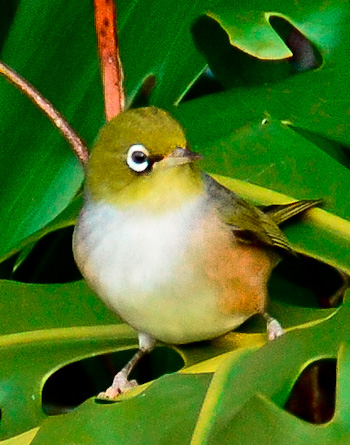
Silvereye - Opua
Native. Abundant. Small green bird with a brilliant white eye-ring. Found anywhere there are trees. Eats nectar, insects, spiders and fruit. Young may be fed by busy parents up to 250 times during a 14-hour day. Can live more than 11 years.

NZ Falcon - George Sound, Fiordland
Native. Not common. Usually found in forests and tussockland but also in rough, high contry farmland on the eastern side of the South Island. We saw several in Fiordland flying among the treetops near the water. Often confused with the larger and more common harrier, it has a hooked bill, powerful feet and strongly curved claws to grab its prey. By far the most aggessive bird of the forest, it even attacking large harriers in flight.


Australasian Harrier - Golden Bay
Native. Very common. Also known as the Harrier Hawk. Often found in the street eating roadkill - possums and hedgehogs. Looks like this one's got a possum. Hunts using sharp claws, not bill, to catch food which may include its own younger brothers and sisters as well as dead sheep and sick lambs. Rodents, small birds lizards frogs, fish and crickets are its normal diet. Can live 18 years.
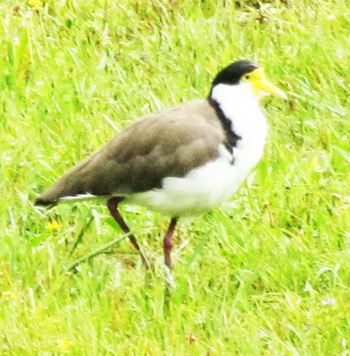
Spur-Winged Plover - Waitomo
Native. Common. Found mainly in farmland but also seen in estuaries. Nests on the ground defending its nest and chicks from magpies and harriers by screeching and dive-bombing. Will strike with their wings or sharp wing spurs. Know to chase people the same way, inflicting wounds with the 1 cm long spur. Lives more than 16 years.
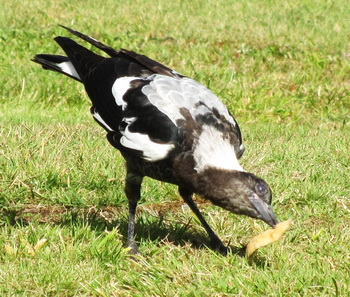
Australian Magpie - Tongariro
Introduced. Very common. Brought to control insect pests on farmland. Fiercely territorial, it attacks many native birds including large ones. Also dive bombs large animals and people approaching its nest, sometimes striking with its claws. Can live nearly 20 years.


Blackbird - female (top) male (bottom) - Gulf Harbour
Introduced. New Zealand's most common bird. The male is shiny black with a bright orange beak and the female is more brown than black. It hops along the ground and can be found crouching on the ground with wings spread to sunbathe or squatting among ants with outstretched wings stimulating the insects to squirt formic acid into its feathers as an insecticide to control mites and lice. Sometimes it picks up ants and places them under its wing feathers. Known to attack its own reflection in a window. Can live for about 20 years
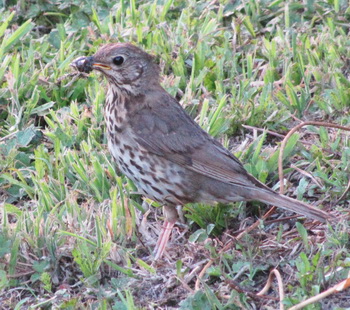
Song Thrush - Whangaparaoa
Introduced. Very common. Runs or hops a few steps before stopping to pick up something to eat. Often carries snails to a favorite rock littered with smashed shells. Can live more than 10 years.

Starling - Stewart Island
Introduced. Very common. Found just about everywhere. It imitates the call of other birds, sounds of traffic, sirens and ringing telephones among other things. They hunt for grubs and worms on the ground as well as flying insects. Competes for food with the bellbird, tui and kereru and can destroy the nests of native birds. Can live for about 20 years.
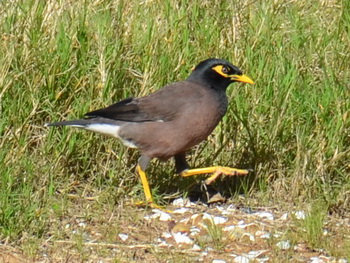
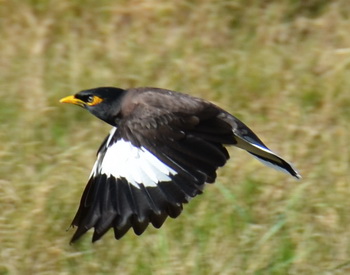
Myna - Opua
Introduced. Common in places on the North Island. Found in towns, gardens, farmland, orchards and on the coast. Feeds mostly on the ground on insects, snails, worms, snails and fruit. A favorite past time seems to be dodging car wheels at the last moment while strutting about the middle of the street. Sometimes kept as pets and taught to speak. The myna can produce two different notes at once, one through each opening of its voice box. It nests in holes of trees, cliffs and buildings. Can live over 12 years.
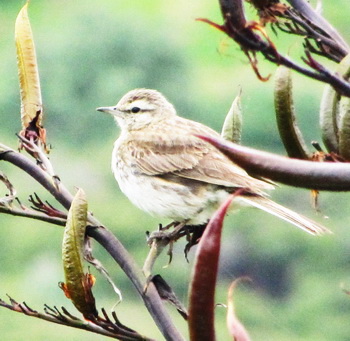
Grey Warbler - Tutukaka
Native. Found only in NZ. Very common. The bird's remarkable song can only be fully appreciated by man when a taped song is slowed down and the complexity understood. It lays just one batch of chicks before the Shining Cuckoo arrives from the Solomon Islands and lays its own eggs in the warbler's nest. A few days after birth the faster growing cuckoo chick shoves out the warbler eggs and chicks. In their place the warbler parents raise a young cuckoo. Grey warblers can live to about 10 years.

House Sparrow - Paihia
Introduced. Very common. Seem to exist nearly everywhere in the world! Brought to NZ in the 1860's to help crops by controlling insect pests but they eat more seeds than bugs. With a taste for crumbs from human food, they have learned to trigger sensors for automatic doors, opening up dining opportunities in cafes, supermarkets and warehouses. Also quite happy to pick bugs out of car radiator grills. Can live 15 years.

Pheasant - Mt. Cook
Introduced. Quite common. Brought to NZ for sport in the 1840's, their feathers have been used by Maori for cloak-making. These two birds came walking through the campsite during breakfast quite unafraid of people and looking for handouts. Can live more than 15 years.

Female and Male Peacocks - Kawau Island
Introduced. Brought to Kawau by Governor Grey along with many other exotic birds, animals and plants. This one wandered around the Mansion House unconcerned by the people just disgorged from the ferry across the expansive lawn.

California Quail - Waitangi
Introduced. Common. Arrived in NZ in the 1860's. Now common in open country with low scrub. Runs along the ground before taking off with a noisy flutter of wings. Lives more than 11 years.

Barbary Dove - Opua
Uncommon. Introduced as a caged bird, some have escaped and established isolated flocks on both islands. Can live to 12 years.
Go to Water Birds of New Zealand